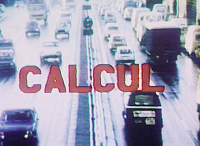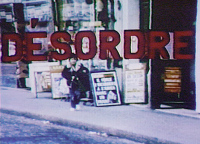


Huitième mouvement (Désordre/Calcul), 1980
BVU, PAL, couleur, son
After their successful project Six fois deux / Sur et sous la communication, Jean-Luc Godard and Anne-Marie Miéville began a second series for television, France / tour / détour / deux / enfants, twelve programmes filmed between Paris and Rolle (Switzerland) in 1977-1978. The form of this series is closer to a normal television production, edited in a way more suitable for broadcasting. Each episode, comprising a short (26-minute) "movement" (as in the musical sense), is constructed in the same way, using codes borrowed from television, sometimes to the point of caricature.
The episode begins with an opening sequence accompanied by a popular song. It already contains elements which are vital to understand what follows, such as the concept of alternation: a small boy holds the microphone while a little girl holds the camera, then vice versa. A metaphor for Jean-Luc Godard's and Anne-Marie Miéville's way of life, becoming children in order to observe better, this shot highlights one of Jean-Luc Godard's recurrent preoccupations: the division of work in a production line and the sexual division linked to it. Then the title of the programme appears in capital letters inserted into the picture, while the voice of one of the two presenters sets out the context of a "monstrous" consumer society, followed by the postulate which they are they are going to oppose. The "TRUE" part, which represents the bulk of the programme, follows the logic of live reporting, with a fixed camera angle (although the picture, always correctly centred, leaves us time to think, unlike television): Robert Linard, who is actually Jean-Luc Godard with a Swiss accent, questions a child about the place where he or she lives, home, school or the street. The journalistic interview is a form used particularly frequently by Jean-Luc Godard in his films, from A bout de souffle onwards. Then comes the "TELEVISION" part: on the set, the presenters - again a man and a woman - criticise what we have just seen and propose a "STORY" capable of providing the viewer with a new way of thinking about the subject, extending it to day-to-day situations. Each episode ends with a discussion between the two presenters, announcing the next episode. This structure did not stop the second channel broadcasting the series in four one-and-a-half-hour programmes, like four full-length films, although it was initially planned to be broadcast one programme a day for two weeks.
Whereas Six fois deux dealt with the production of information and the means of setting up genuine communication, France / tour / détour / deux / enfants attempts to show how television can be used to teach. Already, with the film Le Gai Savoir, commissioned by the ORTF, Jean-Luc Godard had hoped to make a programme a place for the emergence of thought. But Le Gai Savoir remained too didactic, like a "tutor" or "foreman" 1. Unlike that, France / tour / détour / deux / enfants uses a gentle teaching method which encourages the viewers to establish themselves the connections necessary to develop their thinking about the world. The protagonists, Camille and Arnaud, two children of about ten who alternate as the focus of an episode, are the essential element in the teaching method, pretexts for returning to a basic language. More than ever, Jean-Luc Godard and Anne-Marie Miéville, instead of applying the theory through practice, create the theory at the same time as practising it. Since their aim is to "live their lives and see themselves on television" 2, what interests them is not so much the content of these existential questions (the body in time and space, work, freedom), as the way of asking them. In each interview, the journalist's questions involve examining the way of interviewing, itself.
France / tour / détour / deux / enfants therefore appears to be a specific form of maieutics which comes from the experience of living. Thus, the questions dealt with, evoked by the titles, are placed side by side with the activities of everyday life. As the title sequence says, Jean-Luc Godard and Anne-Marie Miéville adapt the 19th-century school book, Le Tour de la France par deux enfants by Gérard Bruno, to contemporary reality: in it, the journey of two brothers served as a pretext for discovering its industrial and agricultural activities, its history and its geography. In France / tour / détour / deux / enfants, although it does not involve a journey through the regions of France, the initiation is a journey in the figurative sense through the ways of life of the French.
The title of each episode, in which the confrontation of words already encourages reflection, associates a school subject with a more generic term whose meaning is explored in philosophical and poetic mode through metaphors. Inserted into the image, the word emerges from a carnal everyday life which becomes a choreography: the body's movements, usually too quick to be perceptible, are broken down. The essential questions lie in our everyday activities which we are not even aware of. And video is better than cinema at revealing associations of ideas: "When the series was ordered by Marcel Julian [Programme Director], it was agreed that we would try to make our work like a novel and like painting, as I believe it is now possible to do with chained images... Cézanne with the means used by Malraux... or philosophy in the form of chamber music." 3
Marie Anne Lanavére
1 Serge Daney, "Le Therrorisé (pédagogie godardienne)", La Rampe, Paris, éd. Cahiers du Cinéma, 1996.
2 Jean-Luc Godard, "Se vivre, se voir", Le Monde, Paris, 30th March 1980 ; reprinted in Godard par Godard, des années mao aux années 80, Paris, Cahiers du Cinéma - éditions de l'Etoile, 1985.
3 Jean-Luc Godard, "La chance de repartir pour un tour" (interview with Claude-Jean Philippe), Les Nouvelles Littéraires, Paris, 30th May 1980 ; reprinted in Godard par Godard, des années mao aux années 80, op. cit.
Huitième mouvement : Désordre / Calcul
The eighth programme proposes a cause-and-effect relationship bringing together the two terms in the title: a system of exaggerated CALCULATION and the multiplication of goods and flows can only result in DISORDER, i.e. Arnaud's shoplifting. The TRUE report itself takes the side of disorder, pushing the live aspect until it interferes with the editorial team's "calculations". Questioning Arnaud and his friend who "couldn't care less" about trade and property, Robert Linard compares television to a trade based on speech. The STORY takes the example of a specific tradesman, the United States' Treasury Secretary - the epitome of capitalism.